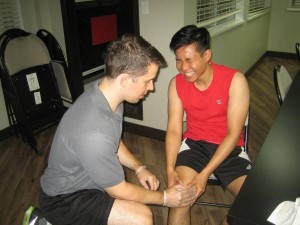A knee dislocation refers to an injury that involves the displacement of the bone in the knee. Injuries that occur due to physical trauma, accidents or falls may cause the ligaments around the knee joint to tear and thus cause the bones of the joint to separate and result in an abnormal alignment.
A knee dislocation injury can be classified into two types: dislocated kneecap and dislocated knee joint.
Most knee injuries and dislocations occur along with knee fractures during accidents or falls. The most common causes of knee dislocations include car/motor vehicle accidents, falls, and sports injuries.
Important Disclaimer: the information posted on this page on knee locations is for learning purposes only. To learn to recognize and manage skeletal and joint injuries enrol in workplace approved first aid training.
Underlying causes
Common causes of knee dislocations include:
- Motor vehicle accidents
- Sports injuries
- Occupational/industrial accidents
- Jumping
- Falls
- Sky diving
Types
Knee dislocations are classified as follows:
- Patella dislocation – the affected knee cap will slide to the knee’s side
- Anterior knee joint dislocation—the fibula and tibula will be in front of the femur of the leg
- Posterior knee joint dislocation – the fibula and tibula will be behind the femur of the leg
Symptoms
The signs and symptoms of kneecap dislocation are as follows:
- Pain in the knee – over the kneecap
- Swelling of the knee
- Difficulty walking
- Difficulty or discomfort while bending the knee
- Knee seems to be mildly deformed
- Stiffness of the knee
- Tenderness of the knee – over the kneecap
Signs and symptoms o knee joint dislocation are as follows:
- Severe pain in the knee
- Severe swelling of the knee
- Deformity of the knee joint
- Inability to stand with the affected knee
- Inability to move the affected knee
- Severe tenderness of the knee
- Unilateral weakness of the knee – below the affected knee
- Unilateral numbness of the knee—below the knee region
Once the casualty is in the hospital the treatment method followed will include relocating the kneecap and then splinting the affected knee.
Additional treatment requirements may include plenty of rest, pain medication, elevation of the affected joint and cold compresses to reduce inflammation.
A knee joint dislocation, however, will require surgery in order to repair the knee fracture and relocate the affected knee joint.
Complications
The complications associated with knee dislocations include:
- Blood vessel injury
- Osteoarthritis
- Osteomyelitis
- Compartment syndrome
- Nerve injury – peroneal nerve injury
- Deep venous thrombosis
- Thrombophlebitis
Treatment
If a person is suffering from the symptoms of knee dislocation as mentioned above, call 911 immediately or take the casualty to the hospital as soon as possible.
Follow these treatment steps until help arrives:
1. Control symptoms
- Apply an ice pack on the affected region to control swelling
2. Immobilize the affected leg
- Immobilize the dislocation right above and below the affected knee. You can use any hard material such as rolled up newspapers or magazines, cardboard or any other stiff object to use as a splint
- Do NOT try to relocate the knee or realign the bones. This may exacerbate the condition
Related Video
http://www.youtube.com/watch?v=J7HIE17bMtY

